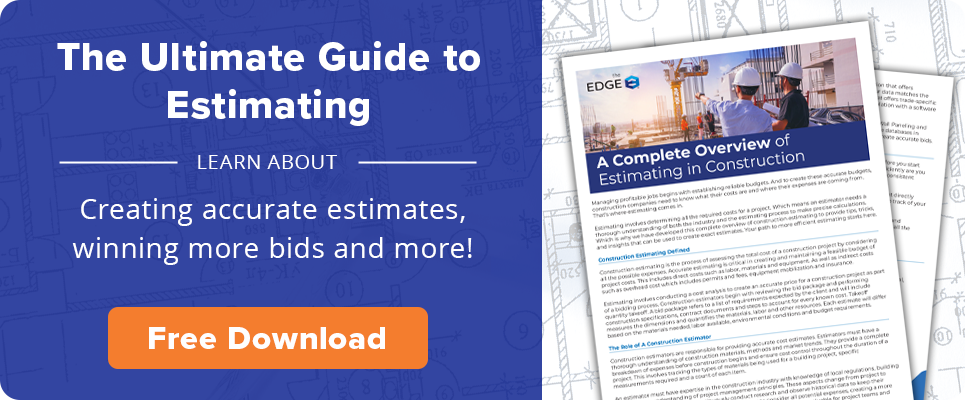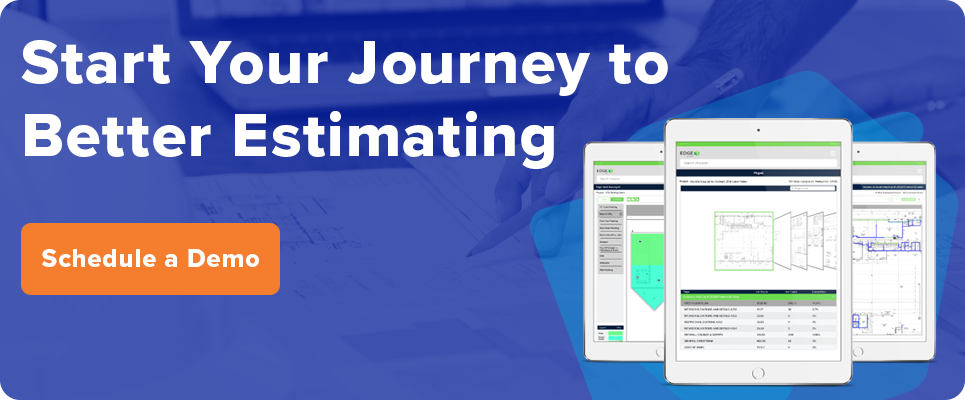
In recent years, sustainable practices have come to the forefront of many industries, and construction is no different.
As project owners become more aware of the cost-saving and planet-preserving benefits of sustainability, estimators must adapt their approach to include these considerations.
This not only aligns with client expectations but also positions firms as leaders as sustainable practices become more prominent.
According to the U.S. Green Building Council, the number of LEED (Leadership in Energy and Environmental Design) projects has been increasing an average of 20% from 2017-2022.
As the construction industry continues to rely more heavily on sustainable building practices, it’s important contractors, project owners and stakeholders understand what it means for their businesses.

Key Takeaways
- Sustainable building projects are becoming more common so contractors should leverage technological tools, such as construction estimating software, to make the transition as smooth as possible.
- Oftentimes, sustainable building practices offer more long-term savings than their traditional counterparts.
- Sustainable materials are oftentimes higher quality and help contractors adhere to sustainability standards.
- Estimators should have a clear understanding of the costs and benefits of using sustainable materials and present their findings to the project owner(s) and other stakeholders.
Understanding Sustainability in Construction
Sustainability in construction includes a range of practices aimed at minimizing environmental impact while maximizing resource efficiency. This includes:
- Use of eco-friendly materials
- Energy-efficient designs to improve energy performance
- Waste reduction
- Practices that promote social responsibility
By prioritizing sustainability, estimators can leverage cost-effective sustainable construction estimating to help project owners reduce long-term operational costs and enhance the value of their projects.
For example, the information listed above can be used to create sustainable construction estimating for net zero buildings.
Identifying Sustainable Materials
The first step for estimators is to familiarize themselves with sustainable materials that can be incorporated into their estimates. Common sustainable materials include:
- Recycled Materials
Using recycled content—such as repurposed steel, glass and plastics — reduces the demand for non-recycled resources and helps with waste minimization. These materials often come at a lower cost and can be easily sourced.
- Sustainable Wood
Certified wood from responsibly managed forests (such as FSC-certified wood) is a popular choice. It has a lower environmental impact compared to non-certified alternatives and often provides aesthetic and structural benefits.
- Low-VOC Products
Volatile organic compounds (VOCs) are harmful to indoor air quality. Estimators should consider low-VOC paints, adhesives and finishes to create healthier indoor environments.
- Energy-Efficient Systems
Incorporating energy-efficient HVAC systems, solar panels and LED lighting can significantly reduce a building’s operational costs and environmental footprint. It could also improve overall energy performance.
- Sustainable Insulation
Materials such as cellulose, sheep’s wool, or recycled denim not only provide effective insulation but also have a lower environmental impact than traditional insulation options.
Knowing what materials to use is only a piece of sustainable estimating, the more difficult aspect is actually adjusting construction estimating practices to account for sustainability.
Adjusting Estimating Practices
Estimators can adopt several practices to incorporate sustainability into their estimates effectively:
- Conduct Lifecycle Cost Analysis (LCCA)
Traditional estimates often focus solely on initial costs, neglecting long-term operational savings.
By conducting life cycle cost analysis for sustainable buildings, estimators can present project owners with a more comprehensive view that includes maintenance, energy savings and replacement costs over the building’s lifespan.
This approach helps project owners see the long-term financial benefits of investing in sustainable materials.
- Use Construction Estimating Software
Using sustainable construction software and tools helps estimators implement sustainable practices and materials into their estimates. This software provides estimators with:
- A secure, centralized location for their real-time data to easily review at anytime from anywhere
- Easily compare material costs and factor in the long-term benefits of using sustainable materials
- Trade-specific databases that allows estimators to compare sustainable material suppliers and make choices that result in the best long-term outcomes
Estimators who use construction estimating software make sourcing sustainable materials easier for their business.
- Engage with Sustainable Suppliers
Building strong relationships with trade-specific suppliers of sustainable materials is crucial.
Estimators should engage with suppliers to stay informed about the latest eco-friendly products and their costs so they can provide accurate estimates while promoting the use of sustainable materials.
- Review Sustainability Standards
Many organizations and certifications, such as LEED, provide guidelines for sustainable construction.
Estimators can reference these standards to ensure their estimates align with best practices in sustainability.
- Educate Stakeholders
Estimators should take the initiative to educate project owners and stakeholders about the benefits and economic viability of sustainable materials and practices.
By highlighting cost savings, potential tax incentives and improved building performance, estimators can create a compelling case for incorporating sustainability into project estimates.
If an estimator makes a concerted effort to perform each step, they can begin to create more sustainable estimates moving forward.
However, these steps do not come without their unique challenges.
Addressing Challenges in Building Sustainable Estimates
Incorporating sustainable practices and materials into estimates may be difficult, especially during the beginning phases.
Some project owners may prioritize initial cost over long-term benefits, making it essential for estimators to effectively communicate the value of sustainability.
This can be achieved through clear presentations of data, case studies of successful projects and emphasis on the growing demand for sustainability across the construction industry.
Additionally, there may be concerns about the availability of sustainable materials and their lead times. Estimators must stay updated on market trends and supply chain sustainability to mitigate these issues.
By proactively addressing potential obstacles, estimators can build trust with project owners and ensure accurate estimates and more bids won.

The Benefits of Building Green Estimates
As the construction industry evolves, the role of estimators in promoting sustainable practices and materials becomes increasingly vital.
By integrating eco-friendly options into their estimates, estimators not only meet the demands of environmentally conscious project owners but also contribute to a more sustainable future.
By embracing sustainability, estimators can help create structures that are not only cost-effective but also environmentally responsible, ensuring a legacy of innovation and stewardship for generations to come.
Go Green With The EDGE®
Sustainable building practices are becoming more prominent so it’s important estimators understand the tools at their disposal to make this transition to green estimating as seamless as possible.
Investing in a construction estimating software allows estimators to easily implement these changes to more sustainable building projects.
The EDGE is an all-in-one takeoff and estimating software for the roofing, interior and exterior finishing trades offers trade-specific databases that make sourcing sustainable materials easy.
Estimators can easily review material costs and make data-driven decisions in real-time that meet or exceed their project’s long-term goals.
For more information about The EDGE, speak with an expert today!





